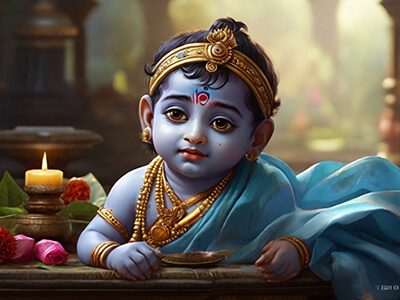
Sri Krishna Govinda (Krishna Lullaby)
Krishna, a central figure in Hinduism, has a childhood and youth filled with miraculous and divine events. The Sri Krishna Govinda mantra uses two of Krishna’s childhood names: Govinda and Gopala. Both of these names are references to Krishna’s pastoral childhood as a cow hearder. Some interpret the prefix “go” as meaning either “cow” or “light.” Symbolically, Krishna protects the sacred.
Kansa is the name of Krishna evil uncle who is the king. He has been trying to kill Krishna since Krishna was born. He received a prophecy that Krishna would overthrow him, and has been out to prevent this since before Krishna’s birth.
As a result, Krishna’s parents have been imprisoned for many years. Read more about Krishna’s history in the article Devakinanadana Gopala. Below are several of the more well-known stories of Krishna’s childhood. They demonstrates Krishna’s divine powers as well as his mischievous youthful nature.
Share this page with a friend!
Watch nearly 400 videos on the Vocal Medicine Channel!
Slaying of the Demoness Putana
The evil king Kansa sends Putana, a demoness disguised as a beautiful woman, to kill the infant Krishna. She smears poison on her breasts and tries to nurse him. However, Krishna, recognizing her true form, suckles with divine force, draining her life away.
Putana screams in agony and falls dead, resuming her terrifying demonic form. The villagers are astonished but relieved, realizing Krishna is no ordinary child. This marks the beginning of Krishna’s divine protection over Gokul, the village where Krishna lives as a child to protect his safety.
Overturning the Cart
During a village festival, baby Krishna is left under a cart loaded with pots. The demon Shakatasura, hiding within the cart, attempts to crush him. Krishna, playing innocently, kicks the cart with his tiny feet, causing it to collapse, destroying the demon instantly.
The villagers are amazed at how an infant could achieve such a feat, while Yashoda dismisses it as divine intervention. Yashoda is Krishna’s foster mother, raising him in the country while Krishan’s parents are imprisoned by Kansa. This miracle hints at Krishna’s extraordinary powers, even in infancy.
Killing the Demon Trinavarta
Kansa sends the demon Trinavarta to attack krishna. Trinavarta takes the form of a powerful whirlwind. As Krishna sits on Yashoda’s lap, he suddenly becomes very heavy, forcing her to put him down. Trinavarta then lifts Krishna high into the sky, hoping to kill him.
However, Krishna suddenly grabs the demon’s neck and strangles him mid-air. The demon crashes to the ground, lifeless. Krishna is unharmed. The villagers are stunned, further confirming that Krishna is divinely blessed and protected.
The Butter Thief
Young Krishna is notorious for stealing butter from the homes of the Gopis. The Gopis are milkmaids, known for their profound love for Krishna. They are his childhood playmates during his time as a cow herder. Krishna’s consort Radhe is the most significant Gopi.
Along with his friends, Krishna sneaks into houses, breaking butter pots and sharing the stolen treats. The Gopis often complain to his foster mother Yashoda, who tries to punish him. However, Krishna’s mischievous charm melts everyone’s hearts.
Krishna’s antics symbolize his divine playfulness. This is known as Lila, translated as “play” or “sport.” The story also teaches that devotion and love are more important than material wealth, as the Gopis joyfully surrender their butter to Krishna.
The Universe Inside of Krishna
One day while playing, Krishna eats some mud. Yashoda scolds him and demands he open his mouth. To her astonishment, she sees the entire universe—planets, stars, and all creation—inside Krishna’s mouth. Overwhelmed by the divine vision, she momentarily realizes Krishna’s true identity.
However, Krishna makes her forget by creating a divine illusion. The ability to create illusion or maya is a supernatural power of the gods as well as demons. This maya allows Yashoda to continue treating him as her beloved child. This event reaffirms Krishna’s divinity while maintaining the intimacy of motherly love.
Breaking the Pots
Krishna and his friends, always eager for butter, find creative ways to steal it from pots hung high in households. They form human pyramids, climbing on each other to reach the prized butter. When caught, Krishna charms his way out of trouble with innocent smiles and clever words.
This playful tradition, symbolizing unity and determination, continues today as the festival of Dahi Handi, where groups compete to break pots hung high, reenacting Krishna’s childhood exploits. Dahi means “curd” and Handi means “earthen pot.”
Lifting Govardhan Hill
When villagers prepare an annual offering to Indra, Krishna advises them to worship Govardhan Hill instead. Enraged, Indra sends torrential rains to punish them. Indra is the king of heaven, a deity sometimes associated with the sky, lightning and thunder.
In response, Krishna lifts the entire Govardhan Hill with his little finger, sheltering the villagers and cattle for seven days. Humbled, Indra realizes Krishna’s divine nature and surrenders. This event establishes Krishna as the supreme protector and reinforces devotion to nature and self-sustaining worship over blind rituals.
Subduing the Serpent
The Yamuna River is poisoned by the multi-hooded serpent Kaliya. The Yamuna River is the second-largest tributary of the River Ganges. This river is personified in the Goddess Yamuna. When Krishna hears of this, he jumps into the river and battles the venomous beast.
Krishna dances on Kaliya’s hoods, forcing the serpent to submit. Krishna orders Kaliya to leave the river, restoring its purity. The villagers rejoice, recognizing Krishna’s supreme power. This event symbolizes Krishna’s ability to purify the world by removing evil and restoring balance.
Krishna Dances with the Gopis
Krishna enchants the Gopis of Vrindavan with his divine flute. Vrindavan is the city associated with Krishna’s childhood. Krishna’s music draws the Gopis into the forest for the mystical Raasa Leela dance. He multiplies himself so each Gopi feels personally attended to.
This dance is not just romance but symbolizes the soul’s longing for the divine. Through devotion, the Gopis experience spiritual fulfillment. Krishna’s Raasa Leela remains a metaphor for divine love, representing the soul’s ultimate union with God through pure devotion and surrender.
Krishna’s Love for Radha
Radha is Krishna’s eternal consort, embodying supreme devotion and divine love. Their relationship transcends the physical, representing the soul’s deep yearning for God. Radha’s love for Krishna is selfless and unconditional, making her the greatest devotee.
Though Krishna later leaves for the city of Mathura and must marry among his own caste, their bond remains unbroken. Their love story inspires bhakti (devotional) traditions, emphasizing love as the highest form of spiritual connection. Radha and Krishna’s love continues to be celebrated today in poetry, music and art.
End of Krishna’s Childhood
The evil king Kansa, fearing Krishna’s growing power, invites him and his older brother Balarama to the city of Mathura under the pretense of a festival. Krishna bids farewell to the Gopis and to his beloved Radha, promising to return.
Upon arrival in mathura, Krishna encounters Kansa’s henchmen, including the fearsome elephant Kuvalayapeeda, whom he effortlessly defeats. Krishna’s entry into Mathura marks the end of his playful childhood in Vrindavan and the beginning of his role as a divine warrior destined to overthrow tyranny and restore justice.
Slaying of The Evil King
In his attempt to kill Krishna, Kansa pits Krishna against his strongest wrestlers in the Mathura arena. Krishna and his brother Balarama defeat them with ease. Enraged, Kansa attempts to kill them himself. However, Krishna leaps onto the throne and pulls him down. He drags Kansa by his hair and slays him.
This fulfills the prophecy that Kansa has feared all of Krishna’s life. The people rejoice, and Krishna frees his parents from prison. This marks the end of Kansa’s tyranny and Krishna’s emergence as a divine ruler and protector.
Author Kathleen Karlsen
Kathleen Karlsen is a musician, artist, writer and speaker. She is the author of two books (Flower Symbols and Vocal Medicine) and over 200 articles. Kathleen, her husband Andrew, and their five children live in Bozeman, Montana. More about Kathleen Karlsen.
Sri Krishna Govinda Article Summary
Krishna, a central figure in Hindu mythology, has a childhood and youth filled with miraculous and divine events. These include defeating demons sent to kill him, lifting a mountain, entrancing milmaids with his divine music, stealing butter and more.







